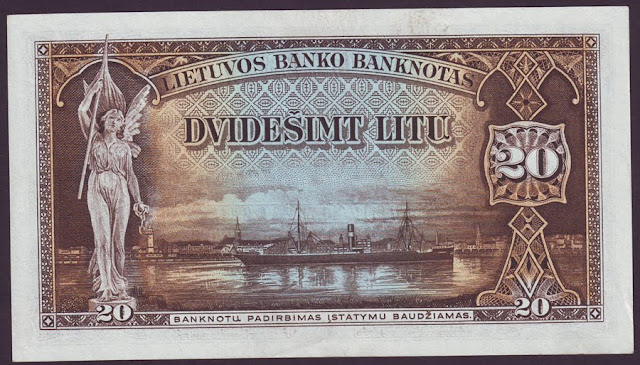Lithuania Currency Litas 20 Litu banknote of 1930
Obverse: Portrait of Vytautas the Great, Grand Duke of Lithuania at left. Church of Vytautas the Great or the Church of the Assumption of the Holy Virgin Mary at center. Signs of Vytautas the Great at right (capital letter "V" in the upper left corner and crossed sabre and spear head on the right. In 15 c. such marking was engraved on monetary units of the Grand Duchy of Lithuania.) Denominations in numerals are in all corners. Centered in words.
Signatures: V. Stašinskas, J. Paknys, J. Masiulis, I. Musteikis, V. Statkus.
Reverse: The paddle steamer on the Neman river, in Kaunas (centered). The reverse also depicts the Statue of Liberty by Juozas Zikaras, commemorating the declaration of Lithuania's independence in 1918. Denominations in numerals are on right side, top right and lower left. In center in words.
Size: 138 x 76 mm.
Designer: Adomas Galdikas.
Printer: Bradbury Wilkinson & Co. England.
Lithuania banknotes - Lithuania paper money
1927-1928 Issue
1924 Issue
1929-1930 "500 Years Vytautas the Great" Commemorative Issues
5 Litai 20 Litu
Church of Vytautas the Great
Church of Vytautas the Great or the Church of the Assumption of the Holy Virgin Mary (Lithuanian: Vytauto Didžiojo bažnyčia) is a Roman Catholic church in the Old Town of Kaunas, Lithuania, and is one of the oldest churches in the city and an important example of Gothic architecture in Lithuania.
The church was built on the north bank of the Neman River around 1400 for Franciscan monks and foreign merchants. It was ordered and funded by Vytautas the Great as a commendation to the Blessed Virgin Mary for saving his life after a major defeat in the Battle of the Vorskla River.
Being quite close to the river the church has suffered many times from spring floods. In 1812 it was burned by French troops. The Franciscan monastery was closed by Russian administration after the November Uprising. In 1845, the Catholic Church was closed and later was rebuilt and reopened as an Orthodox church. From 1903 it served as military barracks. In 1915 Germans organised a warehouse here. The building returned to the Catholic Church in 1919 and underwent major renovation works in 1931–1938, and again in 1978–1982.
Architecture
The church was constructed in Gothic style and is an example of the Lithuanian Brick Gothic architecture. The church layout of the Latin cross is unique in the Lithuanian Gothic. Over the years the ground level around the church has been raised significantly and the façades became lower; to compensate for this, the windows were shortened and the side portals were removed. The bell tower was added later and has probably been used to guide ships navigating the Neman River.
Lithuanian writer Juozas Tumas-Vaižgantas (1869–1933) is buried in the crypt of the church.

